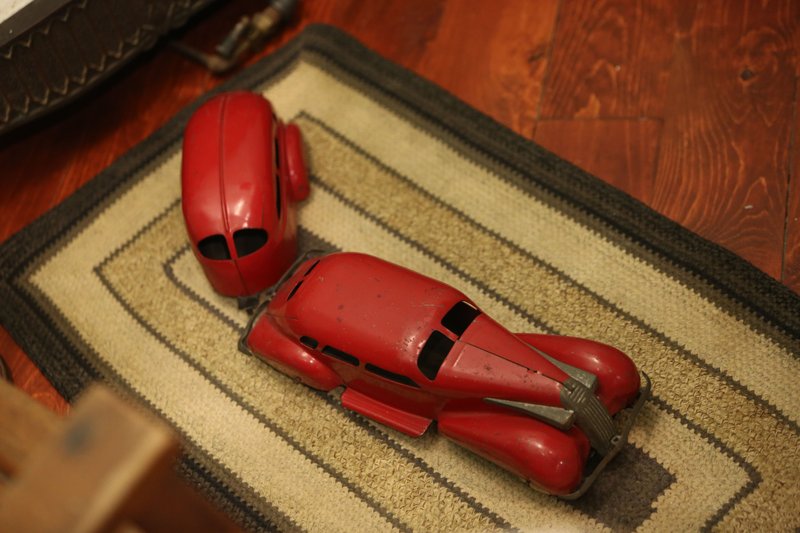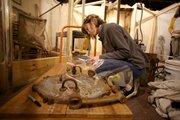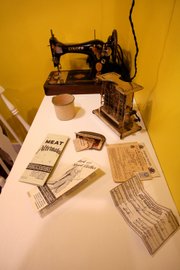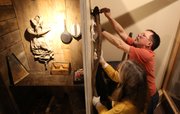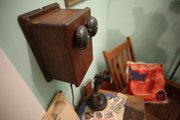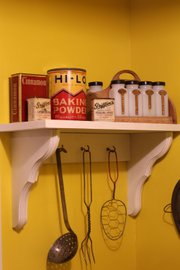The devil is in the details -- but so is the delight.
That's why there's a weathered telephone pole standing in the new Shiloh Museum gallery that opens Saturday. It's why the wiring runs to a period fuse box. And why the siding on the 1940s-style house is made of real wood. And why the lathe and plaster wall that peeks through one end is the real thing, complete with horsehair to bind the plaster.
FAQ
‘The Arkansas Ozarks:
1920 to 1950’
WHEN — Opens Saturday
WHERE — Shiloh Museum of Ozark History in Springdale
COST — Free
INFO — 750-8165
Inside the three rooms depicted, the attention to authenticity reigns supreme. There's an ornate Singer sewing machine, one of the early electric models that didn't require a cabinet, waiting on the kitchen table. Shelves hold Quaker rolled oats -- the precursor to instant oatmeal -- baking powder and spices, and a copper tea kettle is ready on the tiny two-burner stove. There's a vintage iron and an equally old vacuum cleaner in the pantry, metal toys scattered in the living room, and the swing music of the era plays on the period-looking radio in the window of the house.
That's where the modern magic begins. The radio does play World War II era music, but when buttons are pushed, visitors will hear snippets of oral histories from veterans and their wives. They'll be in Spanish and English, thanks to a marvel of electronic engineering created by Curtis Morris, the museum's exhibits manager.
Just days before the exhibit opens, Morris is still scrambling to get all those details right. The mural, "Local Industries," painted by Natalie Henry in 1940 for the Springdale Post Office, requires special lighting with a motion detector to illuminate it only when visitors stop at the display. There are the last of the cabinets to fill and close, interactive touch-screen labels to wire up -- one for the house that talks about the arrival of electricity and gas to homes and home life during the war and the other for a display about the agri-business of the era -- and wall signage won't even happen before Saturday.
That's OK, though. Carolyn Reno, the museum's assistant director and curator of the exhibit, will be on hand to discuss the gallery, which has been 18 months in the making. It's the third in a series of gallery renovations since the museum -- operated by the city of Springdale -- began to look ahead to its 50th birthday in 2018. Without millions of dollars to have the exhibit hall gutted and redone -- and with a desire to never lock the doors -- the senior staff started to consider how to revamp the exhibits, sticking with a timeline that starts in the prehistory of the region and continues to today.
The first gallery, "Settling the Ozarks," curated by Marie Demeroukas, photo archivist and research librarian, opened April 30, 2015. The second, continuing the visitors' journey from the Civil War to World War I, was curated by Judy Costello, the museum's education manager; education specialist Carly Squyres; and Aaron Loehndorf, collections specialist. It debuted last January.
"To be honest, I believe we were assigned our eras," Reno says. "But each person fit their assigned era to a 'T'. I have always enjoyed the culture of the 1920s-1950s era.
"This house display represents an Ozark home of the 1920s to 1940s when the power grid that we take for granted today was being built across the country," Reno returns to the subject at hand. "The telephone arrived in Northwest Arkansas in the 1890s, electricity in the early 1900s, and natural gas in the 1930s. The lines for each system made their way through cities and towns first and then slowly out to farms and remote areas of the Ozarks.
"One fun fact I enjoyed learning was that Springdale was the first town in Northwest Arkansas to get a dial telephone system in 1939," she adds. "The rest of the area, Fayetteville, Rogers, etc., got dial systems in the late 1940s."
That technology plays in to the one of the interactive exhibits in the new gallery.
"There will be a 1930s telephone with instructions on how to dial right out of Springdale's 1939 telephone book when the system was being introduced." Imagine, she adds: "Folks at one time had to learn how to use a dial telephone, and now we will have succeeding generations who won't be familiar with that concept either."
Finding the objects to fill the new exhibit was easy for Reno, who is the museum's collections manager and knows its vaults intimately.
"The museum's collection is strong in this era," she says, pleased. "Early staff members wisely collected material from those years. I have been thanking them over and over again in my thoughts as I go looking for this or that for display. There are a few items that we got outside the museum. For example, I was looking for an old tomato crate recently, and a volunteer with connections to Tontitown tracked one down in a friend's shed out there. Great find. Great luck."
Asked what "blew her away" during her research, Reno turns away from the house to the other side of the new gallery.
"I wouldn't say blown away necessarily, but I've definitely been impressed by the era's produce industry," she says. "I was familiar with the history starting out, but when I really studied the business, I was impressed by what it took to harvest and process all the apples, peaches, grapes, tomatoes, green beans, etc., that were grown here. It was a lot of hard work for a LOT of people, especially since it was before extensive mechanization of harvesting and food processing."
In addition to showcasing machinery of that era, old barn wood was used to re-create a migrant workers' shed during the 1930s, which will feature picking baskets and tickets used by migrant workers to get paid. Also along the south wall of the exhibit will be a discussion of the beginning of agri-business, including area canneries, and a look at the Great Depression in the Arkansas Ozarks.
In the center of the exhibit will be a multi-cased feature with seating, which discusses education, religion, and "civic life" such as fraternal organizations, banking, and civic clubs.
The north wall will feature Northwest Arkansas' response to World War II, both in sending soldiers to war and in "making do" back home, and a look at the post-war Arkansas Ozarks as it begins its economic growth.
Outreach coordinator Susan Young will pick up the story from 1950 to present time in the next gallery, scheduled to open by the end of 2017, and Morris will wrap things up by going back to the beginning -- the Ice Age to the first white arrival -- before the museum's September 2018 celebration.
But first, he's got a few things to finish up before Saturday.
NAN What's Up on 01/13/2017
